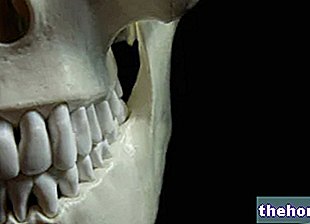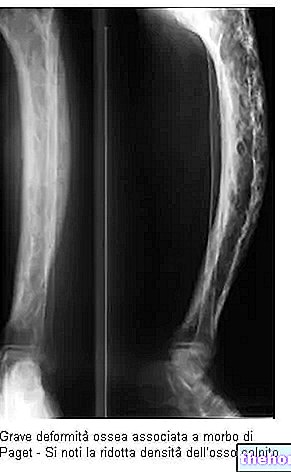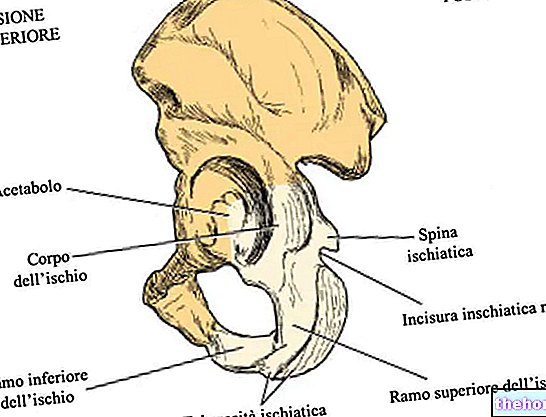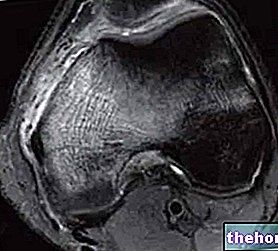
Various factors can cause the reduction in BDM, including: old age, a particular family predisposition to disorders such as "osteopenia or" osteoporosis, cigarette smoking, alcohol abuse, a decrease in estrogen (in women) or testosterone (in men), anorexia nervosa, lack of physical exercise, the intake of certain drugs (chemotherapy or corticosteroids), an incomplete diet, eating disorders, etc.
Osteopenia does not cause symptoms, but rather causes a certain predisposition to fractures.
The treatment of osteopenia involves the adoption of a lifestyle and diet appropriate to the present condition and, sometimes, the use of certain medicines.
What is Bone Mineral Density?
Bone mineral density (BMD, from English Bone Mass Density) is a measure of the amount of minerals (bone mineral mass) contained in one cubic centimeter of bone (volume).
Bone mineral density is an indicator of the resistance to fractures possessed by bones: lower than normal BMD values are indicative of a certain bone fragility and a greater susceptibility, on the part of the skeleton, to suffer fractures.
Bone mineral mass is the parameter that indicates the amount of minerals present in an individual's skeleton.
What is Osteoporosis? Differences with Osteopenia
Osteoporosis is a systemic disease of the skeleton, which causes a strong weakening of the bones. This weakening results from the reduction of bone mass, which, in turn, is a consequence of the deterioration of the microarchitecture of the bone tissue.
People with osteoporosis are more prone to fractures because their bones are more fragile than normal.
Osteoporosis and osteopenia are two very similar conditions, especially as regards the causes and pathophysiological mechanisms.
What distinguishes them - as "can be understood from the definition of osteopenia - is the degree of reduction in bone mineral density, much more severe in the first than in the second.
All this affects the resistance of the bones to fractures: in the case of osteoporosis, the bone fragility is even lower than in the case of osteopenia.
Osteopenia: differences with Osteomalacia, Osteomyelitis and Osteoarthritis
Perhaps because of the similarity between the names, many people tend to confuse osteopenia with three very different bone conditions, which are: osteomalacia, osteomyelitis and osteoarthritis.
- Osteomalacia: it is a skeletal disease characterized by a defective bone mineralization process (N.B: in osteopenia and osteoporosis the mineralization process occurs correctly). The typical consequence of osteomalacia is greater bone fragility.
- Osteomyelitis: is the medical term that indicates the presence of an "infection in the bone.
- Osteoarthritis: it is among the most common forms of arthritis. Arthritis is inflammation of the joints.
What does Osteopenia mean? Origin of the name
The term osteopenia is the result of the union of two words of Greek origin, ostéon (ὀστέον) And penía (πενία).
- Ostéon means "bone"
- Penía it means "poverty" or "shortage".
Therefore, the literal meaning of osteopenia is "bone deficiency" or "bone poverty".
. The bones of the human skeleton are subject to continuous remodeling (or turnover). This remodeling consists in the destruction of a part of the constituent tissues (bone resorption) and in their replacement with newly created tissues (bone deposition).Up to about 30 years of age, the bone remodeling process sees deposition prevail over resorption.
From the age of 30, bone deposition and resorption are equivalent, establishing a sort of equilibrium.
In old age, resorption begins to prevail over deposition and this can lead to the establishment of conditions, such as osteopenia or osteoporosis;
The reduction in estrogen levels, which can be observed in female subjects, is a typical consequence of menopause and represents one of the main factors favoring the onset of osteopenia and osteoporosis;
Did you know that ...
According to a US statistic, about half of Americans over-50s (understood as the inhabitants of the United States of America) suffer from osteopenia.
For further information: Causes of Osteopenia
of any kind.
Its presence, however, is a predisposing factor for bone fractures.
A bone fracture due to osteopenia, as well as that due to osteoporosis, is a very painful condition, which in some anatomical sites (for example, the hip) struggles to heal spontaneously and, for this reason, requires restorative surgery.
Exceptions
Sometimes, osteopenic fractures of the vertebrae of the spine (vertebral or spinal fractures) are inexplicably painless.
In such situations, the identification of the problem occurs in a completely random way.
Does Osteopenia always turn into Osteoporosis?
In various circumstances, the presence of osteopenia is the prelude to a condition of osteoporosis.
However, it should be noted that there are also cases of osteopenia that remain as such, that is, they do not evolve into osteoporosis.
Osteopenia: Complications of Bone Fractures
In old age, osteopenic bone fractures - particularly those of the lower limbs - can severely affect life expectancy, causing the affected person to die prematurely.
In these situations, among the possible causes of death, the venous thrombosis related to immobility and stasis pneumonia are particularly noteworthy.
Osteopenia: who to turn to?
Depending on the triggering or suspected causes, osteopenia and osteoporosis can be of interest to geriatricians, gynecologists, endocrinologists, orthopedists, rheumatologists and nutritionists.
(DEXA).Bone densitometry is a diagnostic technique that allows to evaluate, usually at the level of the spine, hip, wrist, fingers and / or tibia, the bone mineral density of an individual.
Remember that bone mineral density is that parameter that is lower than normal in the case of osteopenia and osteoporosis.
Other diagnostic tests, which doctors could use in case of suspected osteopenia, are: quantitative computed tomography, peripheral quantitative computed tomography and quantitative bone ultrasound.
Bone densitometry: Osteopenia, T score and Z score
The instrument for bone densitometry describes the bone mineral density of an individual through two parameters, named by doctors "T score" And "Z score'.
The "T score"is the measure of how much the bone mineral density value of the examined subject differs from the reference value, represented by the healthy population aged 25-30 and of the same sex.
Lo "Z score", on the other hand, is the measure of how much the bone mineral density value of the subject examined differs from the reference value, represented by the healthy population of the same age and sex.
To diagnose the presence of osteopenia, the parameter of interest is theT score": if an individual presents a"T score"between -1 and -2.5, then he suffers from osteopenia.
In the table below, the reader can see the values that the "T score", based on bone health.
Value of T score
Bone health
≥ -1
<-1 and ≥ -2.5
< -2,5
<-2.5 with fracture
The main physical exercises of load include: walking, marching, dancing, hiking, climbing stairs, aerobics, light running (non-severe osteopenia), etc.
For weight-bearing exercises to be effective, a patient must perform them at least 2-3 times a week.
Stronger and less rigid muscles reduce the risk of falls, and therefore also of fractures.
To see the results of resistance exercises, it is good to do them 2-3 times a week.
Diet and Osteopenia: What to Eat
In the case of osteopenia, the most suitable diet is the one that provides for an intake (or intake) adequate calcium and vitamin D.
The foods most rich in calcium are: milk, dairy products, green leafy vegetables, etc.
The foods with the highest vitamin D content, on the other hand, are: eggs, salmon, sardines, swordfish and fish oil, etc.
In some particular situations, doctors may deem it essential to support the "intake diet of calcium and vitamin D with special supplements.
Please note
Our body is able to exploit the vitamin D introduced with food only if it is exposed to sunlight.
The sunlight, in fact, triggers a cellular process that transforms the vitamin D, present in food, from a form unsuitable for the human organism to a form usable for it.
Medicines for Osteopenia
Medicines for osteopenia include:
- Bisphosphonates. They are medicines capable of increasing bone mineral density, limiting the decalcification process of the bones.
The bisphosphonates most administered in case of osteopenia are: alendronate, risedronate, ibandronate and zoledronic acid. - The selective estrogen receptor modulators. They are drugs that stimulate estrogen receptors, inducing effects similar to the latter (except on the uterus and breasts).
A selective estrogen receptor modulator commonly used in osteopenia is raloxifene. Raloxifene has the effect of increasing bone mineral density. - The teriparatide. It is a substance similar to parathyroid hormone. Its function is to stimulate bone deposition.
- Calcitonin. It has the effect of decreasing bone resorption.
- The denosumab. It is a drug that, due to its induced effects, can replace bisphosphonates when these are responsible for adverse effects in the patient.

.jpg)


























